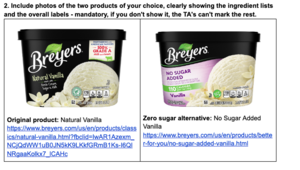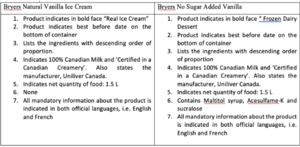Course:FNH200/Assignments/2022/Bryers Ice Cream Vanilla
Bryers Vanilla Ice Cream (Natural and No Sugar Added)
Image of both products
Refer to embedded image
Ingredient lists (5 points)
| Breyers Ice cream - Natural Vanilla | Breyers Ice cream - No Sugar Added Vanilla |
|
|
Fat/ Sugar substitutes ( Bryers Ice Cream, Natural Vanilla)
Fat substitutes: modified milk ingredients - a protein-based fat substitute (Simplesse®) is digested as a protein and due to the process of microparticulation, contributes only 1.0-1.3 Cal/g. Used to give the ice cream a creamy texture and act as a stabilizer to extend shelf life.
FDR DIVISION 16, TABLE IV: Food Additives That May Be Used as Emulsifying, Gelling, Stabilizing and Thickening Agents
- Additive: Mono- and Diglycerides; is a food additive that is used as an emulsifier to prevent milk fat (dispersed phase) from separating from the water/skim milk (continuous phase). It also acts as a stabilizer to extend the shelf life as well as improving texture by acting as a thickening agent.
- Additive: Vegetable gums (guar and carob bean); a food additive that is used as a thickening agent to impart body and give the ice cream a thicker texture and Mono- and Di-glycerides
Sugar Substitute - none
Fat/ Sugar substitutes ( Bryers Ice Cream, No Sugar Added)
Sugar Substitutes : artificial sweeteners like acesulfame potassium and sucralose. Contains a sugar substitute: maltitol syrup
Role of fat/sugar substitutes and additives
The use of fat replacements in food items allows for the preservation of the food's original qualitative attributes while avoiding the hazards connected with fat consumption. Products using fat replacements have less calories than full-fat counterparts because they lack energy-dense fat molecules.
Sugar replacements give sweetness and taste enhancement to foods without adding calories. They do not contribute to tooth decay, unlike sugar. The majority of them do not raise blood sugar levels.
Food additives are compounds that are added to food in order to preserve or improve its safety, freshness, flavour, texture, or appearance.
Comparison of both products (with differences explained)
| Breyers Ice cream - Natural Vanilla | Breyers Ice cream - No Sugar Added Vanilla |
| |
|
|
| Maltitol syrup is a low-calorie sweetener and sugar substitute, which is defined as “any food additive used to impart a sweet taste to food” by the Food and Drug Relations of Canada (FDR). It is also under the sugar-alcohol category of sweeteners, which is known to be less sweet than sugar and does not increase blood glucose or insulin levels. Due to maltitol’s high melting point and creamy texture, it is used as a substitute flavored coating on frozen items.
Excessive sugar intake is a risk factor for individuals with diabetes, those with high calorie intake and tooth decay (ie., cavity) concerns, and other health problems. Those with such health concerns may opt for sugar substitutes, like maltitol, to enjoy sweetened food products without the risk of a high sugar and calorie intake and other health repercussions. | |
|
|
| Maltodextrin is a carbohydrate-based fat substitute, which is known to produce a smooth “mouth feel'' to food, while having less calorie content than fat. Maltodextrin is added to non-sugar alternatives, like the No Sugar Added vanilla ice cream alternative, to add a smoother texture and overall more pleasurable eating experience. Additionally, individuals at risk for health complications may opt for no sugar | |
|
|
| Vegetable gum is used as a thickener and stabilizer for ice cream products. It is also known to aid bowel regularity. While vegetable gum may be generally safe in moderation, producers of healthy ice cream alternatives limit content as it may trigger allergic reactions, cause gas and bloating, and other health problems in high doses. | |
|
|
| Whey protein is a common ingredient found in low fat, low sugar ice cream alternatives. It is also considered a type of protein-based fat substitute added to stablize and give texture to food. Producers of healthy ice cream alternatives opt for whey to allow consumers to enjoy the product’s taste and texture, while acting as an energy source and a form of muscle repair, as well as lessening fat intake. | |
|
|
| Vitamin A is usually added to all low-fat and fat-free milks. This is to supplement and replace vitamin content lost through the removal of milk fat in healthy food alternatives, such as the No Sugar Added vanilla ice cream alternative. | |
Labels (2 points)
Labeling
Labelling of both products is claimed within SmartLabelTM which is governed by Health Canada. Breyers states that it makes its product with 100% Grade A Milk and Cream which is in alignment with DIVISION 8 (dairy products) of the Food and Drugs Act of Canada.
Both products comply with the IDENTITY AND COMPOSITIONAL standards. I.e. both products state what the food item is and contain the lists of mandatory and permitted ingredients in food.
Both products also comply with the following food labelling requirements (based on Consumer Packaging and Labelling Act and Regulations) I.e.
- Common name of food-
- Date marking
- List of ingredients
- Country of origin
- Net quantity of food
- Sweeteners
- Bilingual labeling
- Nutrition Table List ( refer to image labelled 'Nutrition Table List')
Please see embedded screenshot for detailed information on compliance of regulations


